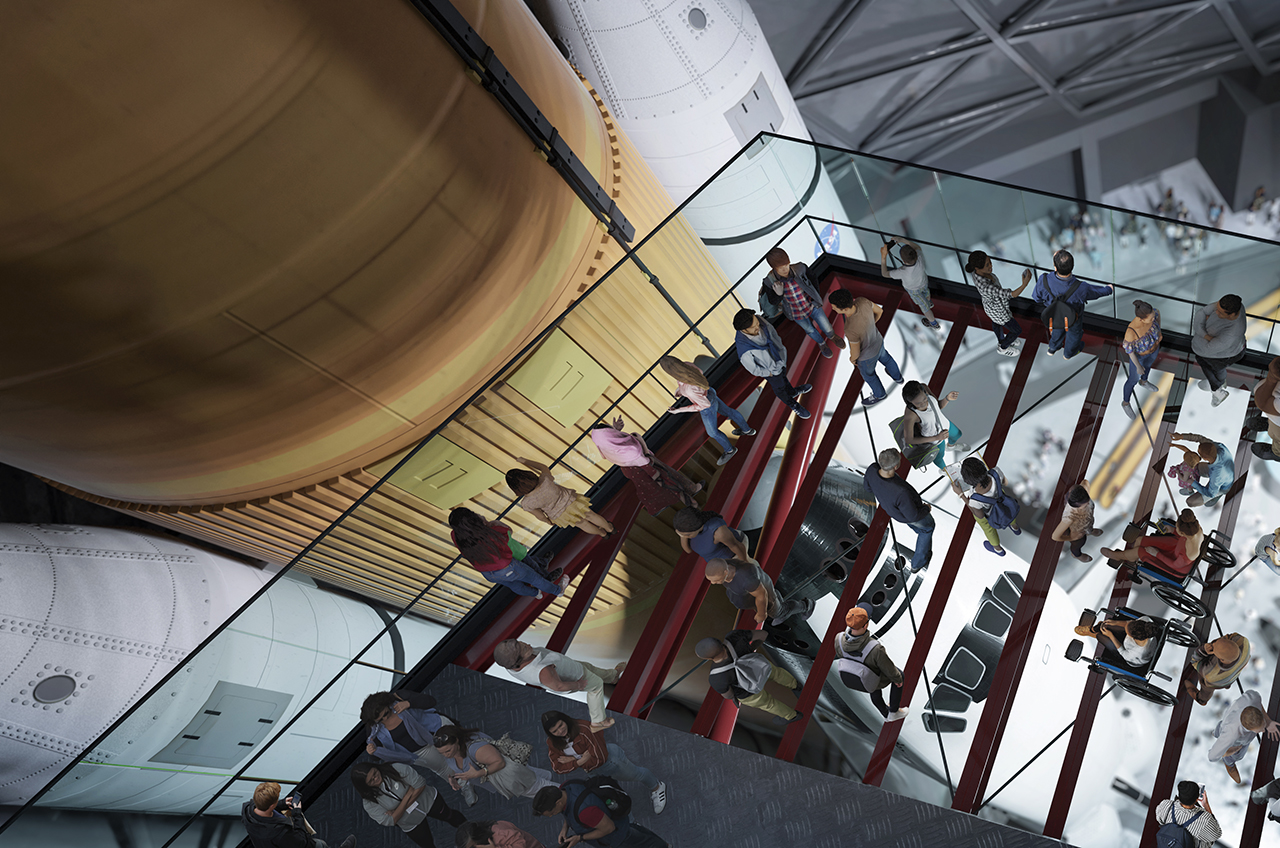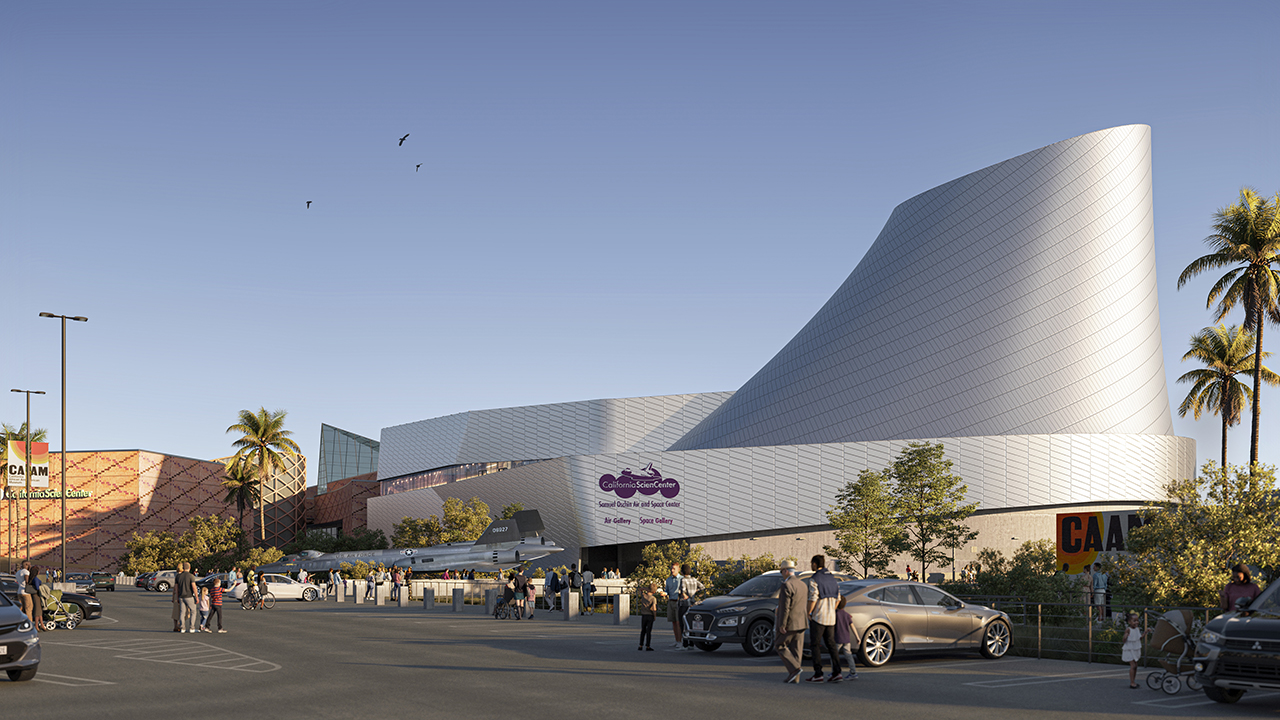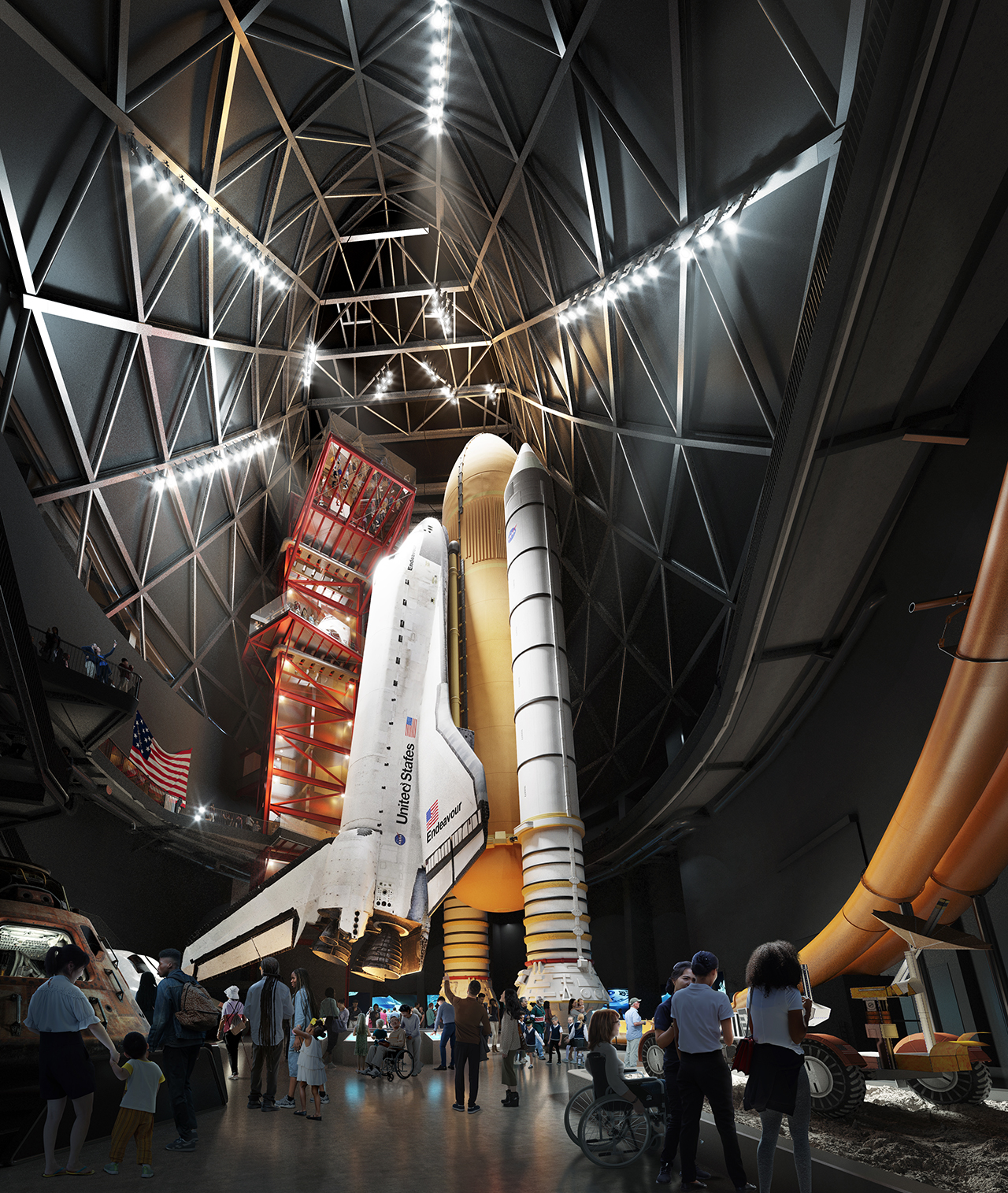Groundbreaking sets stage for space shuttle Endeavour launch-like display
The California Science Center's new Samuel Oschin Air and Space Center will tower 20 stories tall.

It is an up-close sight that gave astronauts a reason to pause, and soon it will be one that the public can see for themselves: a space shuttle standing poised for launch.
The California Science Center on Wednesday (June 1) is breaking ground for its new Samuel Oschin Air and Space Center, which will become the permanent home of NASA's retired space shuttle Endeavour. Unlike the science center's current display of the orbiter, which for the past 10 years has had Endeavour positioned horizontally atop its mobile transporter, the new exhibit will showcase the full space shuttle stack — including an external tank and twin solid rocket boosters — in a gallery towering 20 stories tall at Exposition Park in Los Angeles.
"The California Science Center is thrilled to celebrate this milestone today," Jeffrey Rudolph, president and CEO of the California Science Center, said in a statement. "The Samuel Oschin Air and Space Center will be a launchpad for creativity and innovation to inspire the next generation of scientists, engineers and explorers."
Related: NASA's space shuttle program in pictures
Local and state elected officials, former NASA astronauts, students and donors were invited to join Rudolph and other science center leaders for Wednesday's private ceremony. A day long in the making — early plans for the expansion were in place when Endeavour was delivered to the science center in 2012 — it has again been made possible by a donation from the new museum's namesake.
"This gift is to honor the legacy of my dear husband Samuel Oschin, who was passionate about adventure and the pursuit of knowledge, especially in the fields of science and engineering," said Lynda Oschin. "It gives me enormous pleasure to see this vision becoming a reality for the millions of young people who will be inspired to reach for the stars."
Although the amount was not disclosed, the gift from the Mr. and Mrs. Samuel Oschin Family Foundation was the largest the California Science Center has ever received. Combined with the support provided by the State of California and numerous foundations, individuals and corporate donors, the science center has now raised $280 million toward its $400 million goal to cover the past, present and future of Endeavour's display.
Breaking space news, the latest updates on rocket launches, skywatching events and more!
"Few institutions have seen this level of generosity, and we are tremendously grateful to Mrs. Lynda Oschin for the unparalleled gift," said Rudolph. "Their early contribution was catalytic in bringing space shuttle Endeavour to the California Science Center, and we are forever thankful for this additional commitment that has propelled us forward to groundbreaking on the Samuel Oschin Air and Space Center."

Other major donors include The Ahmanson Foundation, Thomas and Dorothy Leavey Foundation, Weingart Foundation and Ibrahim El-Hefni Technical Training Foundation. The science center plans to raise the remaining $120 million during the construction period and is still accepting members for Team Endeavour by sponsoring one of the shuttle's thermal tiles.
"On behalf of the citizens of California, thank you to the many generous supporters of the Samuel Oschin Air and Space Center project," said Gavin Newsom, governor of California. "We have achieved this groundbreaking milestone because of all of you, and together we will inspire the next generation."
Going up
The footprint for the 200,000-square-foot (19,000 square meters) Samuel Oschin Air and Space Museum was cleared ahead of Wednesday's ceremony.
"The demolition of the old buildings is done already, so the next step will be excavation and shoring to get the building going," Rudolph told collectSPACE in an interview. "Then probably the most notable next public thing will be installing Endeavour and the full stack."
Roughly a year and a half from now, in the second half of 2023, Endeavour will be taken off display and moved the short distance to where it will displayed in the new air and space center. There it will joined by External Tank-94 (ET-94), NASA's last remaining shuttle fuel tank built for flight, and two solid rocket boosters assembled from segments that were used in the launch of 81 shuttle missions.
The California Science Center has recruited a team of former and current space program workers with experience mating the space shuttle and NASA's new Space Launch System (SLS) megarocket to stack Endeavour. At one point, the prevailing thought was to mount the full shuttle stack in the horizontal and then lift it all together, but it turned out the tried-and-true way was still the best way.
Endeavour: NASA's youngest space shuttle (reference)

"We did a lot of a lot of engineering on horizontal stack concepts because we honestly thought it was going to be easier," said Dennis Jenkins, a veteran shuttle engineer and director of the science center's project to display Endeavour. "The further we got into it, though, the more it was causing us grief. So we went back to doing it the 'old fashioned' way, just without a VAB [Vehicle Assembly Building]."
Each component will be raised individually by crane, with the solid rocket boosters going up first, followed by the external tank and then Endeavour. They will be connected to each other using the same hardware that was used for launches.
"It is absolutely a flight stack. We will use hold-down bolts to secure the boosters to a seismic isolator, but everything from there on up will be exactly like we would have stacked it at NASA," Jenkins told collectSPACE.
Once Endeavour is standing in place, the museum building will be erected around it. Scaffolding that was used to access the shuttle's attach points during mating will be reused to support a cover to protect the vehicle from damage.
"Building construction will take about three years," said Rudolph.
Astronaut's-eye view
When it opens, the Samuel Oschin Air and Space Center will have 150 exhibits spanning three multi-level galleries — titled "Air," "Space" and "Shuttle" — spread across four floors and 100,000 square feet (9,000 square meters) of exhibit space.
In addition to Endeavour, the museum will display flown Mercury, Gemini and Apollo capsules, an array of engineering models of planetary probes, a SpaceX Dragon cargo spacecraft and approximately 20 aircraft ranging from a replica of the Wright Brothers' 1902 Glider to modern supersonic jet fighters.
Inside the Shuttle gallery, guests will be able to view Endeavour from multiple angles. Visitors will be able to take an elevator up to glass-floor platforms to get a look inside the crew hatch, peer into the payload bay (one of the two 60-foot-long [18 m] doors will be open) and look down at the vehicle below.

They will also be able to walk up to and under the shuttle, standing in the same relative area where astronauts stood on the launch pad to gaze up at their soon-to-be ride into space.
"There is that moment when pretty much everybody has cleared out of the launch pad except for the crew and a few others on the day of launch and you got to stand right below Endeavour, very close, at the bottom looking up at it," said Greg Chamitoff, a former NASA astronaut who launched on Endeavour twice, including its final mission in 2011, and now teaches aerospace engineering at Texas A&M University. "At that moment, it is not a static object; it's a living, breathing, smoking, noisy machine that seems just raring to go. It feels alive."
"I don't think they're going have the sound effects — maybe that's a good idea," Chamitoff said with a laugh, "but I think standing there is going to bring back the sense of getting on this amazing machine and launching on that particular day."
Click through to collectSPACE to see more of the new renderings of space shuttle Endeavour in the California Science Center's Samuel Oschin Air and Space Center.
Follow collectSPACE.com on Facebook and on Twitter at @collectSPACE. Copyright 2022 collectSPACE.com. All rights reserved.

Robert Pearlman is a space historian, journalist and the founder and editor of collectSPACE.com, a daily news publication and community devoted to space history with a particular focus on how and where space exploration intersects with pop culture. Pearlman is also a contributing writer for Space.com and co-author of "Space Stations: The Art, Science, and Reality of Working in Space” published by Smithsonian Books in 2018.
In 2009, he was inducted into the U.S. Space Camp Hall of Fame in Huntsville, Alabama. In 2021, he was honored by the American Astronautical Society with the Ordway Award for Sustained Excellence in Spaceflight History. In 2023, the National Space Club Florida Committee recognized Pearlman with the Kolcum News and Communications Award for excellence in telling the space story along the Space Coast and throughout the world.

